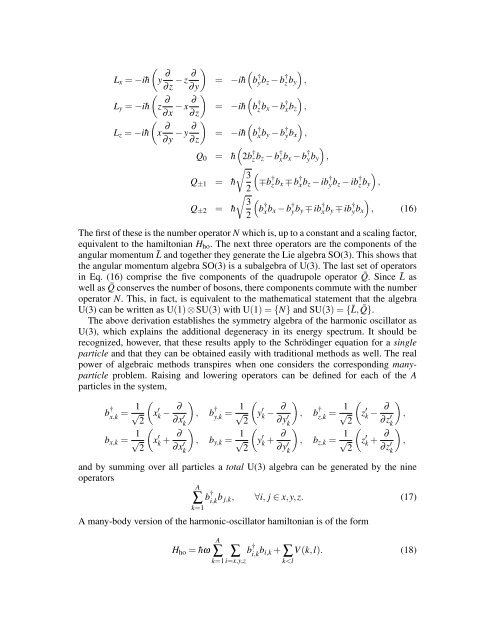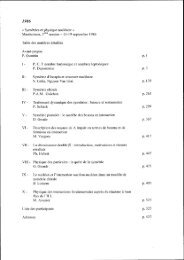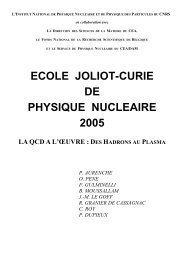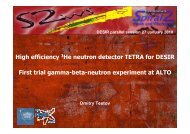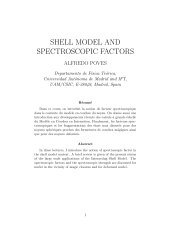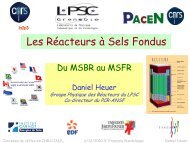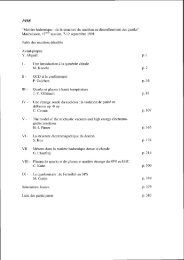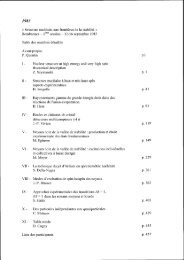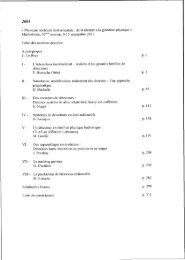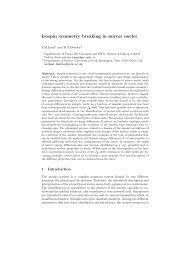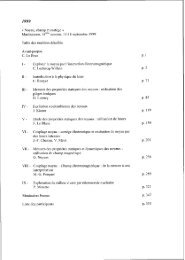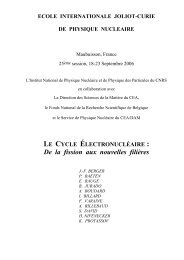SYMMETRIES IN NUCLEI - Cenbg - IN2P3
SYMMETRIES IN NUCLEI - Cenbg - IN2P3
SYMMETRIES IN NUCLEI - Cenbg - IN2P3
Create successful ePaper yourself
Turn your PDF publications into a flip-book with our unique Google optimized e-Paper software.
(L x = −i¯h y ∂ ∂z − z ∂ )∂y(L y = −i¯h z ∂ ∂x − x ∂ )∂z(L z = −i¯h x ∂ ∂y − y ∂ )∂z)= −i¯h(b † yb z − b † zb y ,)= −i¯h(b † zb x − b † xb z ,)= −i¯h(b † xb y − b † yb x ,)(2b † zb z − b † xb x − b † yb yQ 0 = ¯h√3Q ±1 = ¯h2√3Q ±2 = ¯h2(∓b † zb x ∓ b † xb z − ib † yb z − ib † zb y),,(b † xb x − b † yb y ∓ ib † xb y ∓ ib † yb x), (16)The first of these is the number operator N which is, up to a constant and a scaling factor,equivalent to the hamiltonian H ho . The next three operators are the components of theangular momentum ¯L and together they generate the Lie algebra SO(3). This shows thatthe angular momentum algebra SO(3) is a subalgebra of U(3). The last set of operatorsin Eq. (16) comprise the five components of the quadrupole operator ¯Q. Since ¯L aswell as ¯Q conserves the number of bosons, there components commute with the numberoperator N. This, in fact, is equivalent to the mathematical statement that the algebraU(3) can be written as U(1) ⊗ SU(3) with U(1) = {N} and SU(3) = {¯L, ¯Q}.The above derivation establishes the symmetry algebra of the harmonic oscillator asU(3), which explains the additional degeneracy in its energy spectrum. It should berecognized, however, that these results apply to the Schrödinger equation for a singleparticle and that they can be obtained easily with traditional methods as well. The realpower of algebraic methods transpires when one considers the corresponding manyparticleproblem. Raising and lowering operators can be defined for each of the Aparticles in the system,b † x,k = 1 √2(x ′ k − ∂∂x ′ kb x,k = 1 √2(x ′ k + ∂∂x ′ k), b † y,k = 1 √2(y ′ k − ∂∂y ′ k), b y,k = √ 1 (y ′ k + ∂2 ∂y ′ k), b † z,k = √ 1 (z ′ k − ∂2 ∂z ′ k), b z,k = √ 1 (z ′ k + ∂2 ∂z ′ k),),and by summing over all particles a total U(3) algebra can be generated by the nineoperatorsAb † i,k b j,k, ∀i, j ∈ x,y,z. (17)∑k=1A many-body version of the harmonic-oscillator hamiltonian is of the formH ho = ¯hωA∑k=1∑i=x,y,zb † i,k b i,k + ∑ V (k,l). (18)k


